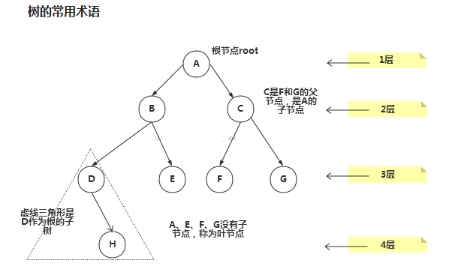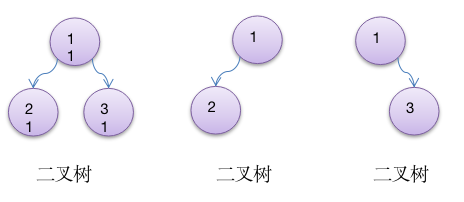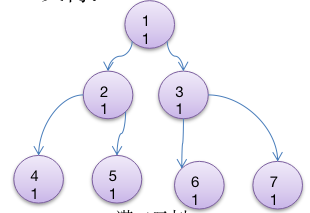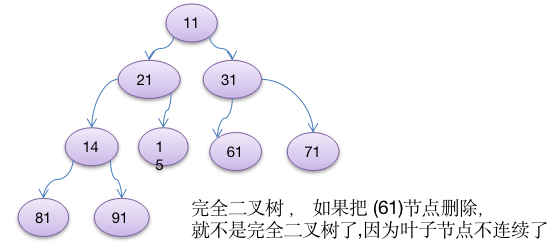數據結構--二叉樹(Java) 博客說明 文章所涉及的資料來自互聯網整理和個人總結,意在於個人學習和經驗彙總,如有什麼地方侵權,請聯繫本人刪除,謝謝! 樹的常用術語(結合示意圖理解) 節點 根節點 父節點 子節點 葉子節點 (沒有子節點的節點) 節點的權(節點值) 路徑(從root節點找到該節點的路 ...
數據結構--二叉樹(Java)
博客說明
文章所涉及的資料來自互聯網整理和個人總結,意在於個人學習和經驗彙總,如有什麼地方侵權,請聯繫本人刪除,謝謝!
樹的常用術語(結合示意圖理解)

- 節點
- 根節點
- 父節點
- 子節點
- 葉子節點 (沒有子節點的節點)
- 節點的權(節點值)
- 路徑(從root節點找到該節點的路線)
- 層
- 子樹
- 樹的高度(最大層數)
- 森林 :多顆子樹構成森林
樹存儲方式優勢
能提高數據存儲,讀取的效率, 比如利用 二叉排序樹(Binary Sort Tree),既可以保證數據的檢索速度,同時也可以保證數據的插入,刪除,修改的速度
二叉樹的概念
-
每個節點最多只能有兩個子節點的一種形式稱為二叉樹

-
二叉樹的子節點分為左節點和右節點
-
如果該二叉樹的所有葉子節點都在最後一層,並且結點總數= 2^n -1 , n 為層數,則我們稱為滿二叉樹。

-
如果該二叉樹的所有葉子節點都在最後一層或者倒數第二層,而且最後一層的葉子節點在左邊連續,倒數第二層的葉子節點在右邊連續,我們稱為完全二叉樹

遍歷
- 前序遍歷: 先輸出父節點,再遍歷左子樹和右子樹
- 中序遍歷: 先遍歷左子樹,再輸出父節點,再遍歷右子樹
- 後序遍歷: 先遍歷左子樹,再遍歷右子樹,最後輸出父節點
代碼
package cn.guizimo.tree;
/**
* @author guizimo
* @date 2020/7/29 8:03 下午
*/
public class TreeDemo {
public static void main(String[] args) {
BinaryTree binaryTree = new BinaryTree();
HeroNode root = new HeroNode(1, "宋江");
HeroNode node2 = new HeroNode(2, "李逵");
HeroNode node3 = new HeroNode(3, "盧俊義");
HeroNode node4 = new HeroNode(4, "吳用");
HeroNode node5 = new HeroNode(5, "林沖");
HeroNode node6 = new HeroNode(6, "魯智深");
//創建二叉樹
root.setLeft(node2);
root.setRight(node3);
node2.setLeft(node4);
node3.setLeft(node5);
node3.setRight(node6);
binaryTree.setRoot(root);
//前序遍歷
// HeroNode heroNode = binaryTree.preOrderSearch(5);
// System.out.println(heroNode);
}
}
/**
* 二叉樹
*/
class BinaryTree {
//根節點
private HeroNode root;
public void setRoot(HeroNode root) {
this.root = root;
}
//刪除二叉樹的節點
public void delNode(int no) {
if (root != null) {
if (root.getNo() == no) {
root = null;
} else {
root.delNode(no);
}
} else {
System.out.println("二叉樹為空");
}
}
//前序
public void preOrder() {
if (this.root != null) {
this.root.preOrder();
} else {
System.out.println("二叉樹為空");
}
}
//中序
public void infixOrder() {
if (this.root != null) {
this.root.infixOrder();
} else {
System.out.println("二叉樹為空");
}
}
//後序
public void postOrder() {
if (this.root != null) {
this.root.postOrder();
} else {
System.out.println("二叉樹為空");
}
}
//前序查找
public HeroNode preOrderSearch(int no) {
if (root != null) {
return root.preOrderSearch(no);
} else {
return null;
}
}
//中序查找
public HeroNode infixOrderSearch(int no) {
if (root != null) {
return root.infixOrderSearch(no);
} else {
return null;
}
}
//後序查找
public HeroNode postOrderSearch(int no) {
if (root != null) {
return this.root.postOrderSearch(no);
} else {
return null;
}
}
}
/**
* 節點
*/
class HeroNode {
private int no;
private String name;
private HeroNode left;
private HeroNode right;
public HeroNode(int no, String name) {
this.no = no;
this.name = name;
}
public int getNo() {
return no;
}
public void setNo(int no) {
this.no = no;
}
public String getName() {
return name;
}
public void setName(String name) {
this.name = name;
}
public HeroNode getLeft() {
return left;
}
public void setLeft(HeroNode left) {
this.left = left;
}
public HeroNode getRight() {
return right;
}
public void setRight(HeroNode right) {
this.right = right;
}
@Override
public String toString() {
return "HeroNode{" +
"no=" + no +
", name='" + name + '\'' +
'}';
}
//刪除節點
public void delNode(int no) {
//判讀左節點是否為空,找到
if (this.left != null && this.left.no == no) {
this.left = null;
return;
}
//判斷右節點,找到
if (this.right != null && this.right.no == no) {
this.right = null;
return;
}
//判斷左節點,未找到,遞歸
if (this.left != null) {
this.left.delNode(no);
}
//判斷右節點,未找到,遞歸
if (this.right != null) {
this.right.delNode(no);
}
}
//前序
public void preOrder() {
System.out.println(this);
if (this.left != null) {
this.left.preOrder();
}
if (this.right != null) {
this.right.preOrder();
}
}
//中序
public void infixOrder() {
if (this.left != null) {
this.left.infixOrder();
}
System.out.println(this);
if (this.right != null) {
this.right.infixOrder();
}
}
//後序
public void postOrder() {
if (this.left != null) {
this.left.postOrder();
}
if (this.right != null) {
this.right.postOrder();
}
System.out.println(this);
}
//前序遍歷查找
public HeroNode preOrderSearch(int no) {
if (this.no == no) {
return this;
}
HeroNode resNode = null;
//判斷左子樹
if (this.left != null) {
resNode = this.left.preOrderSearch(no);
}
if (resNode != null) {
return resNode;
}
//判斷右子樹
if (this.right != null) {
resNode = this.right.preOrderSearch(no);
}
return resNode;
}
//中序遍歷查找
public HeroNode infixOrderSearch(int no) {
HeroNode resNode = null;
if (this.left != null) {
resNode = this.left.infixOrderSearch(no);
}
if (resNode != null) {
return resNode;
}
if (this.no == no) {
return this;
}
if (this.right != null) {
resNode = this.right.infixOrderSearch(no);
}
return resNode;
}
//後序遍歷查找
public HeroNode postOrderSearch(int no) {
HeroNode resNode = null;
if (this.left != null) {
resNode = this.left.postOrderSearch(no);
}
if (resNode != null) {
return resNode;
}
if (this.right != null) {
resNode = this.right.postOrderSearch(no);
}
if (resNode != null) {
return resNode;
}
if (this.no == no) {
return this;
}
return resNode;
}
}
感謝
尚矽谷
萬能的網路
以及勤勞的自己
關註公眾號: 歸子莫,獲取更多的資料,還有更長的學習計劃



